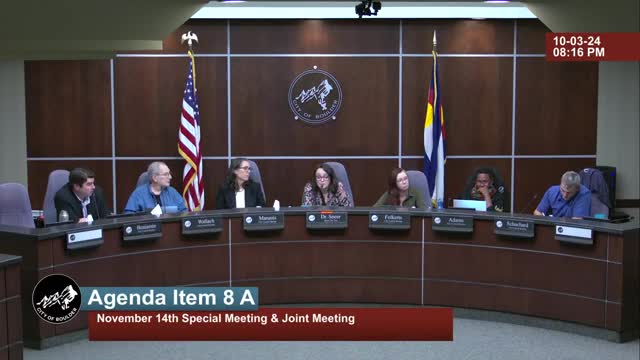Boulder County faces backlash over proposed budget cuts
October 03, 2024 | Boulder, Boulder County, Colorado
This article was created by AI summarizing key points discussed. AI makes mistakes, so for full details and context, please refer to the video of the full meeting. Please report any errors so we can fix them. Report an error »

During a recent government meeting, officials engaged in a critical discussion regarding Boulder County's proposed budget cuts for 2025, emphasizing the potential impact on local social services and community programs. The meeting, which was confirmed to be held in person, began with a clarification that the discussions were centered on Area 3, which is part of the updated comprehensive plan.
Council members Matt and Mark led the conversation, expressing concerns about the disconnect between city and county budgets and the implications of the proposed cuts. They highlighted that significant reductions—such as a 20% cut to the Emergency Family Assistance (EFA) community grant program and a 30% cut to All Roads—could severely affect essential services like the day service center and night shelter, especially as winter approaches.
The council members proposed drafting a letter to Boulder County to seek clarity on the budget cuts and their potential effects on the community. They stressed the importance of understanding how these cuts could harm vulnerable populations who rely on these services. Mark noted that the cuts pose a \"very clear threat\" to economically vulnerable individuals, and there has been insufficient dialogue between the city and county regarding these issues.
Several council members echoed the need for improved communication and collaboration between the city and county, particularly in the budgeting process. Tyesha acknowledged ongoing staff-level discussions but emphasized the necessity for direct engagement between elected officials to address these pressing concerns.
The council reached a consensus to move forward with drafting the letter, aiming to gather more information on the budget cuts and their implications for city services and community partners. The letter is expected to be sent out within days, reflecting a proactive approach to addressing the anticipated challenges posed by the county's budget decisions.
In addition to the budget discussions, the meeting also touched on the importance of monitoring and reporting on community cultural grants, with officials expressing a desire for greater clarity on how investments are made, particularly concerning racial equity and the outcomes of funded programs. This reflects a broader commitment to ensuring that community needs are met effectively amid financial constraints.
Council members Matt and Mark led the conversation, expressing concerns about the disconnect between city and county budgets and the implications of the proposed cuts. They highlighted that significant reductions—such as a 20% cut to the Emergency Family Assistance (EFA) community grant program and a 30% cut to All Roads—could severely affect essential services like the day service center and night shelter, especially as winter approaches.
The council members proposed drafting a letter to Boulder County to seek clarity on the budget cuts and their potential effects on the community. They stressed the importance of understanding how these cuts could harm vulnerable populations who rely on these services. Mark noted that the cuts pose a \"very clear threat\" to economically vulnerable individuals, and there has been insufficient dialogue between the city and county regarding these issues.
Several council members echoed the need for improved communication and collaboration between the city and county, particularly in the budgeting process. Tyesha acknowledged ongoing staff-level discussions but emphasized the necessity for direct engagement between elected officials to address these pressing concerns.
The council reached a consensus to move forward with drafting the letter, aiming to gather more information on the budget cuts and their implications for city services and community partners. The letter is expected to be sent out within days, reflecting a proactive approach to addressing the anticipated challenges posed by the county's budget decisions.
In addition to the budget discussions, the meeting also touched on the importance of monitoring and reporting on community cultural grants, with officials expressing a desire for greater clarity on how investments are made, particularly concerning racial equity and the outcomes of funded programs. This reflects a broader commitment to ensuring that community needs are met effectively amid financial constraints.
View full meeting
This article is based on a recent meeting—watch the full video and explore the complete transcript for deeper insights into the discussion.
View full meeting
